LABORgLAskAtALOg LABORATORY GLASSWARE CATALOGUE
LABORgLAskAtALOg LABORATORY GLASSWARE CATALOGUE
LABORgLAskAtALOg LABORATORY GLASSWARE CATALOGUE
Sie wollen auch ein ePaper? Erhöhen Sie die Reichweite Ihrer Titel.
YUMPU macht aus Druck-PDFs automatisch weboptimierte ePaper, die Google liebt.
TECHNICAL INFORMATION | PRODUCT SECTION<br />
What is glass ?<br />
Glass is an inorganic mixture fused at high temperature which solidifies on cooling but does not<br />
crystallize. Its basic components, network formers and modifiers, are present in the common glasses<br />
in the form of oxides.<br />
Typical glass formers (network formers) are silicon dioxide (SiO 2<br />
), boric acid (B 2<br />
O 3<br />
), phosphoric acid<br />
(P 2<br />
O 5<br />
) and aluminium oxide (Al2O 3<br />
). These substances are capable of absorbing (dissolving) metal<br />
oxides up to a certain proportion without losing their glassy character. This means that the incorporated<br />
oxides are not involved in the formation of the glass but modify certain physical properties of the<br />
structure of the glass as “network modifiers”.<br />
A large number of chemical substances have the property that they solidify from the molten state<br />
into a glassy state. The formation of glass depends on its cooling rate and a necessary prerequisite<br />
is the existence of mixed types of bond (covalent bonds and ionic bonds) between the atoms or<br />
groups of atoms.<br />
As a result, glass-forming products show a strong tendency whilst still in the molten state towards<br />
amorphous three-dimensional networking though polymerisation. Crystals are formed when the<br />
individual atoms form a regular three-dimensional arrangement in what is known as a “crystal lattice”<br />
as soon as the particular substance changes from the liquid to the solid state. Glass, however, forms<br />
a largely amorphous “network” when it cools down from the molten state. The components mainly<br />
involved in the formation of the glass are therefore described as “network formers”. The glass-forming<br />
molecules in this network can incorporate ions that open up the network at certain points, changing<br />
its structure and thus the properties of the glass. They are therefore called “network modifiers”.<br />
What is DURAN ® ?<br />
The special features of DURAN ®<br />
Very high chemical resistance, nearly inert behaviour, a high usage temperature, minimal thermal<br />
expansion and the resultant high resistance to thermal shock are its most significant properties.<br />
This optimum physical and chemical performance makes DURAN ® the ideal material for use in the<br />
laboratory and for the manufacture of chemical apparatus used in large-scale industrial plant. It is<br />
also widely used on an industrial scale in all other application areas in which extreme heat resistance,<br />
resistance to thermal shock, mechanical strength and exceptional chemical resistance are required.<br />
Chemical composition of DURAN ®<br />
DURAN ® has the following approximate composition:<br />
81 % by weight SiO 2<br />
13 % by weight B 2<br />
O 3<br />
4 % by weight Na 2<br />
O/K 2<br />
O<br />
2 % by weight Al 2<br />
O 3<br />
DURAN ® properties are specified in DIN ISO 3585.In contrast to other borosilicate 3.3 glasses,<br />
DURAN ® is notable for its highly consistent, technically reproducible quality.<br />
203



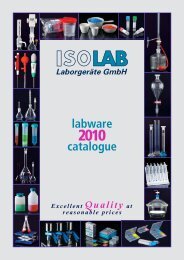
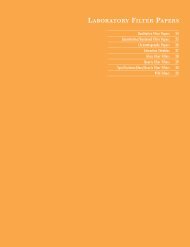
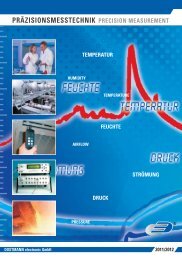
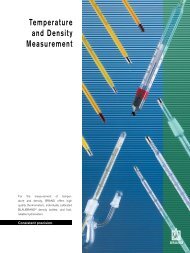
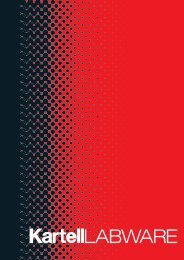

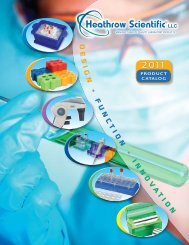


![Download [12.5MB] - Labtek](https://img.yumpu.com/24756492/1/184x260/download-125mb-labtek.jpg?quality=85)
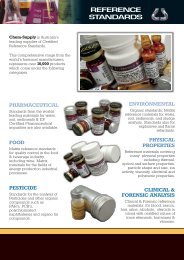
![DYMO Healthcare Brochure [2MB] - Labtek](https://img.yumpu.com/24756484/1/190x240/dymo-healthcare-brochure-2mb-labtek.jpg?quality=85)
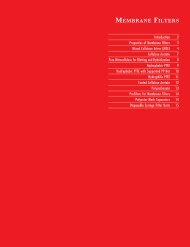
![Download [12.5MB] - Labtek](https://img.yumpu.com/24756470/1/184x260/download-125mb-labtek.jpg?quality=85)